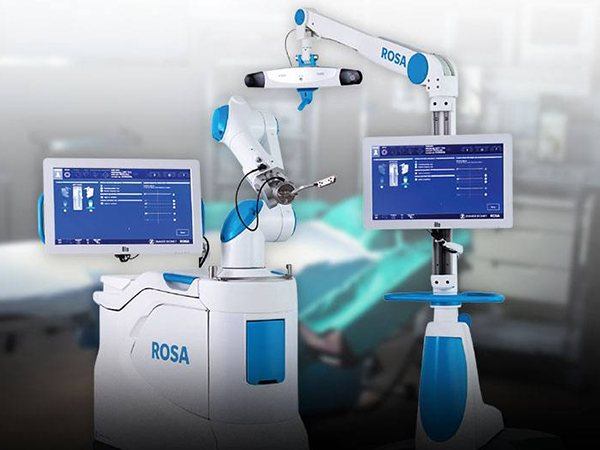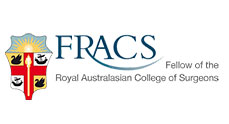French Consultant Orthopedic Surgeon Dr. Sebastien Parratte one of the world’s recognized pioneers in Robotic Orthopedic & Knee Arthroplasty Surgeries is available at International Knee & Joint Center using the latest medical technology – Rosa Robot

International Knee & Joint Centre (IKJC) is Centre of Excellence specializing in the diagnosis and treatment patients with knee, shoulder and other joint injuries and disorders. Located in the heart of Abu Dhabi. An interview was conducted with Dr. Sebastien Parratte to know more about Knee Arthroplasty Surgeries, herein is the details:
What is Knee Arthroplasty Surgery?
It is a surgical procedure to resurface a knee damaged by osteoarthritis. Titanium and extra resistant plastic parts are used to cap the ends of the bones that form the knee joint, along with the kneecap.
Are there different types of Knee Arthroplasty Surgeries?
Yes, there are different types of arthroplasty. Options include:
- Tricompartimental knee arthroplasty: the 3 compartments of the knee are replaced
- Partial knee arthroplasty: only the affected part of the knee is replaced
- Bilateral knee arthroplasty: R and L knee arthroplasties are performed at the same time
Who should consider knee arthroplasty?
Patients with pain and/or limitations in the activities of their daily life should consider the surgery when all the medical treatments failed to control the symptoms. The pain is most of the time related to the disappearance of the cartilage. Osteoarthritis is the condition leading to the disappearance of the cartilage. When the patient is “bone on bone”, the pain is often major and surgery is then an excellent solution.
Osteoarthritis is a very common reason that people have knee surgery but surgery may also be needed in people with:
- A knee injury such as a ligament tear or meniscus tear
- A knee deformity that they were born with
- Rheumatoid arthritis
The patient will be requested to do some tests for the surgeon to decide if she/he needs a surgery or not. After a adapted examination of the knee, the surgeon and the patient will discuss together about the modalities of the most adapted treatment. If and when surgery is the ideal treatment, the surgeons will provide all the required information’s to the patient. Pro and cons, the preparation for the surgery and the surgical pathway will be explained to the patient.
What happens during the surgery?
Most knee arthroplasty surgeries are performed under a combination of spinal (epidural) anesthesia associated to peripheral nerve blocks, and light general sedation. The patient will also receive at least one dose of antibiotics to reduce the risk of infection.
During the procedure, the surgeon will remove the diseased cartilage from where your thigh bone (femur) and shin bone (tibia) meet at your knee joint using dedicated instruments and robotic guidance to assist and optimized the surgical procedure. The patient bone and all the structure around the knee (ligaments, muscles …) are preserved using efficient minimally-invasive surgical techniques.
Those surfaces are then replaced with a titanium implant. A piece a “super resistant plastic” is normally used to replace the backside of the kneecap and finally, this same plastic material is placed in between the two titanium parts. This gives both bones of your knee joint smooth surfaces again so they can flex and bend more freely and painlessly. The component used are expected to last 20 to 25 years.
What happens directly after the surgery?
Most patients spend 2–3 nights in the hospital following a knee replacement arthroplasty, sometimes less.
The latest modern pain management protocols will be applied and pain medication will be prescribed and the patient will be monitored for any complications.
The patient will start to walk the day of the surgery or the next day using initially crutches. The day after the surgery, a physical therapist will start helping the patient with dedicated training exercises. The goals for this first day are to be able to stand, sit and walk properly.
When the patient is able to perform certain tasks, such as getting out of bed alone and using the bathroom, she/he will be able to go home.
The patient may need to use a cane or walker for a short period of time after the operation.
Physical therapy sessions will be scheduled for the patient soon after the surgery to start the rehabilitation journey
Actives exercises will be performed to help the patient to get back to her/his normal life.
HOW IS THE PAIN AFTER KNEE ARTHROPLASTY SURGERY?
I’m telling the patients that, here at International Knee & Joint Centre, we are using the latest & best pain management protocols to avoid pain after knee arthroplasty as much as possible. Despite that, we observed that some patients are still in pain after surgery and some have absolutely no pain and can even leave the hospital the day after the surgery.
The pain perception is very viable and we cannot promise the patient that she/he won’t have pain but we can promise that we will do our best to limit the pain as much as possible. On the longer term, the pain is most of the time going away and fading progressively. Once again there is a higher variation between patients and for some patients the pain goes away very quickly and some take more time and this has no consequence on the longer-term results.
WHICH ACTIVITY CAN THE PATIENT PRACTICE AFTER KNEE ARTHROPLASTY SURGERY?
From our experience and different researches that we have performed on the sportive activities after arthroplasty, most of the patients involved in sporting activities can return to their previous activities after surgery without having pain. The whole point is the level of practice before the surgery and the higher the level before the surgery the higher the level will be after arthroplasty. Of course, if they never practice sports before, we are not going to tell them to start to learn about this sport after surgery.
Concerning the activities and the type of activities, all the sports have been evaluated in several studies that we performed with the Mayo Clinic and some patients were able to go back to ski, to do even moderate football or basketball, even though it is not something that we can push or highly recommend. Definitely jogging and long distance running or weight-lifting are not ideal. However, on the longer term and up to more than 10-years after surgery, we observed that the implants were still doing very well for the patients doing high impact physical activities which means that the sportive activities didn’t lead to more worn-out of the plastic and titanium parts. More interestingly, patients practicing moderate and/or high impact sports activities after surgeries were doing better on the long run because they had less diabetes, less osteoporosis and less obesity.
Another important question that we should discuss is “Doctor can I go back to pray kneeling down after the surgery?”, and the answer is “YES”. The ability to pray kneeling down is very much correlated to the surgical technique and the type of implant that we use, we do everything for the patient to get the maximum range of knee flexion respecting the natural envelope of the knee thanks to the robotic technology. We observed, however that the capacity to go back to pray kneeling down is directly related to the length of time that the patient stops to pray kneeling down before the surgery. In fact, the patient stops to pray kneeling down five years before the surgery, it is going to take much more time for the patient to go back to pray after surgery than if he stops to pray five months before the surgery. Most of the time, the patient can start to practice the sujud and praying kneeling down four months after the surgery for bilateral tricompartmental or unicompartmental knee arthroplasty and two months after surgery for a partial knee replacement.
Are there any complications might result from the surgery?
All surgeries can involve complications. After knee Arthroplasty surgery, there may be a risk of: infection, blood clots, continuing pain, even when the surgery is successful & stiffness.
More than 98 % of the patients however don’t experience any complications after surgery and are very happy.
The healthcare team in IKJC is highly specialized and all advanced processes are implemented to ensure that the risks are as low as possible but like when you are flying a plane: the “risk zero” doesn’t exist.
What is Partial knee Arthroplasty?
In a partial knee Arthroplasty, the surgeon only resurfaces the part of your knee that is damaged.
Compared with a tricompartimental knee Arthroplasty, this procedure has the following advantages:
- It needs a smaller incision which means less pain and less blood loss.
- All the natural ligaments are preserved.
- Recovery is usually faster and less painful.
With modern implants and indications, partial knee arthroplasties can now last as long as a tricompartimental arthroplasty and the common believe that a partial knee arthroplasty is a temporary procedure before the tricompartimental knee arthroplasty is not true anymore.
Sometimes the osteoarthritis is however too advanced for your surgeon to offer you a partial knee arthroplasty.
What is Bilateral knee Arthroplasty?
In bilateral knee arthroplasty surgery, the surgeon replaces both knees at the same time.
If the patient has Osteoarthritis in both knees, this is an excellent option, as it means you only have to go through the procedure and recovery process once. When both knees are affected and the patient has a good medical condition, doing both knee at the same time has been shown as a better option than doing one by one. The rehabilitation journey with the modern protocols is not harder than for one knee only.
WHEN CAN WE GO BACK TO PRACTICE PHYSICAL ACTIVITIES?
For walking and cycling, the patient can go back to walking and cycling one month after the surgery and the same thing for swimming. Initially, we ask the patient to do more freestyle swimming rather than breast stroke. Rowing activities at the gym or elliptical training is also possible one month after the surgery. Outdoor sports, longer walks or hiking, golfing are most of the time possible between 2 and 4 months after the surgery depending on the athletic capacity of the patient. For the higher impact activities such as skiing, moderate football or basketball, it might take up to six months.
What to expect after the treatment journey?
The patient can expect to go back to her/his life as before the osteoarthritis. The results are mostly related to the patient general health condition and the joint replacement recovery times vary because every patient reacts differently to surgical intervention. The individual’s genetics, their overall health, and the complexity of the procedure all influence how quickly the patient will be back to normal (or better) after a knee arthroplasty.
While recovery times can vary depending on pre-operative fitness and other factors, it is important to know that improvements continue for 12 months after surgery as muscles and soft tissue get stronger and range of movement expands.
Why patients should choose IKJC for Knee Arthroplasty?
Surgeons in IKJC have a huge experience in the field of Knee Arthroplasty with more than 5000 surgeries experience. The IKJC Knee Specialists are worldwide recognized Knee expert, teaching and training other surgeons all over the world on the latest techniques in knee Arthroplasties including minimally-invasive robotic surgeries.
International Knee & Joint Center has been the first orthopedic center Asia & Meddle East to introduce and use the Rosa robotic technique for knee arthroplasty surgeries. When using ROSA robot, the surgeon remains in charge and the Robot is acting as a “super-assistant”. Higher accuracy and better outcomes have been observed when using ROSA. Following the IKJC experience, more than 6000 knee arthroplasties have been performed worldwide using ROSA and one new ROSA unit is installed every week in the US, Europe or Asia-Pacific. Our IKJC surgeons have trained nearly 1000 surgeons over the world on how to do robotic knee arthroplasties using ROSA.
Here at IKJC, we make sure that we are using premium implants perfectly adapted to the anatomy of the patient. The premium implants that we are using are almost like custom-made implant, and when implanted with robotic technique described earlier it is an extremely personalized surgery that we can offer to our patients in order to restore as much as possible the anatomy of the normal knee, then allowing them to return to a more normal life after the surgery. This point is also very important as it seems there are very few centers in the middle-east using the combination of this type of implant and the robotic technique.
As for the ACL and sport surgeries of the knee, IKJC is a high-volume and leading center for personalized robotically-assisted knee arthroplasties.”





